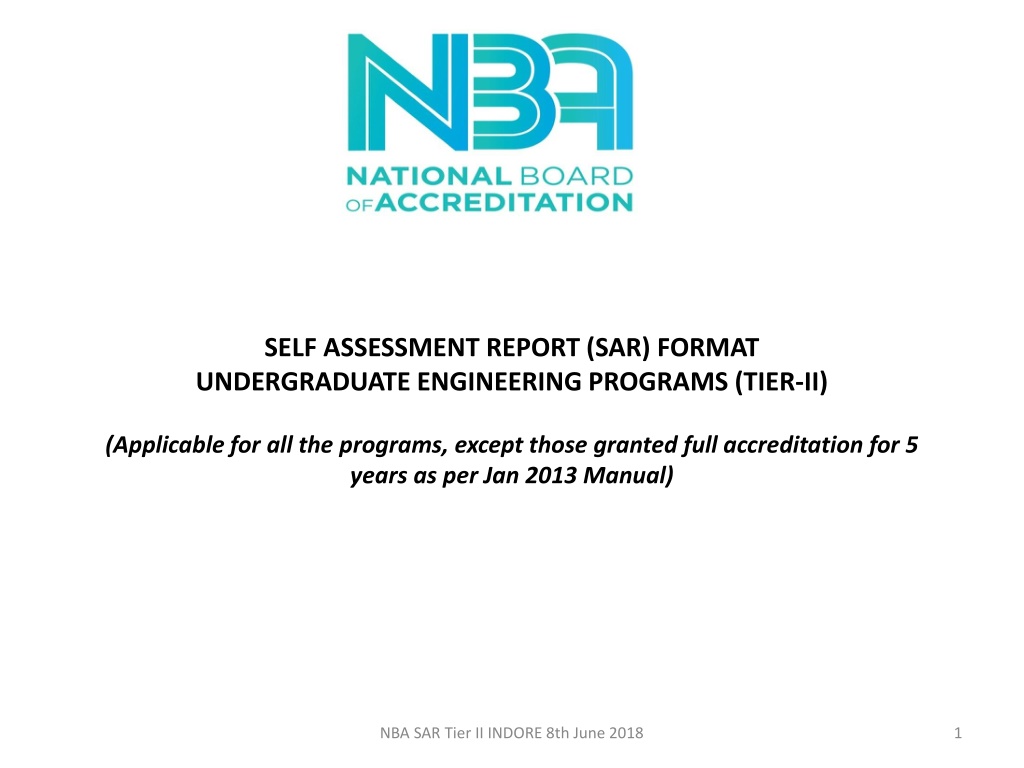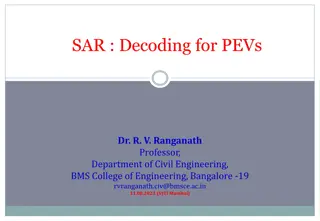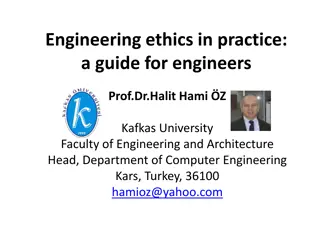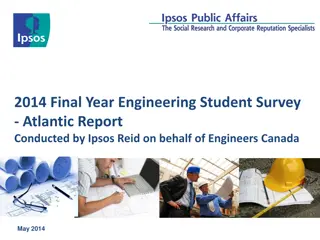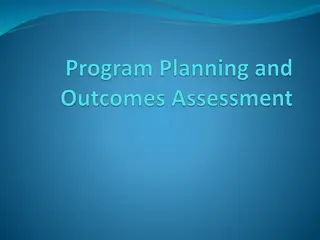Engineering Program Self-Assessment Report Format Overview
Technical education in engineering programs requires defined processes and adequate resources for achieving stated outcomes. The self-assessment report format for Tier-II undergraduate engineering programs outlines the importance of processes, resources, monitoring, evaluation, and improvement. Criteria with different weightages are used to assess program quality and identify areas of concern or deficiency, requiring remedial actions for enhancement.
- Engineering education
- Self-assessment report
- Program outcomes
- Accreditation process
- Educational resources
Download Presentation

Please find below an Image/Link to download the presentation.
The content on the website is provided AS IS for your information and personal use only. It may not be sold, licensed, or shared on other websites without obtaining consent from the author. Download presentation by click this link. If you encounter any issues during the download, it is possible that the publisher has removed the file from their server.
E N D
Presentation Transcript
SELF ASSESSMENT REPORT (SAR) FORMAT UNDERGRADUATE ENGINEERING PROGRAMS (TIER-II) (Applicable for all the programs, except those granted full accreditation for 5 years as per Jan 2013 Manual) NBA SAR Tier II INDORE 8th June 2018 1
SAR forms the basis for (first time) accreditation process SAR prepared and submitted to NBA by the institute applying for accreditation SAR is per Programme ( UG, PG) we will take up Engineering Programmes Tier I University (Deemed-to-be, State, Central) and Autonomous affiliated colleges Tier II affiliated colleges (Non-autonomous) NBA SAR Tier II INDORE 8th June 2018 2
University/College web site is also a source of information about the college The visit to the institution is for 2 days (Friday and Saturday) Pre-visit meeting on Thursday and Exit meeting on Sunday. Two PEs per programme The report is finalised on Day 2 by evening (late) jointly by the 2 PEs. The report forms the input to NBA for further processing regarding accreditation. NBA SAR Tier II INDORE 8th June 2018 3
Overview: Technical Education is a service provided via processes for achieving stated outcomes, Programme outcomes / course outcomes Processes require definition and execution. Processes also require resources Resources group broadly into 1. Human - Students, faculty, Technical support and administrative support 2. Financial- recurring (opex),non-recurring (capex) 3. Infrastructure Labs, Library, class rooms .. NBA SAR Tier II INDORE 8th June 2018 4
Implementation of Processes include monitoring, evaluation, feedback and improvement. Criteria and weightages Criteria have sub and sub-sub criterion Weightages are in levels of Y, C, W and D YES (fully met), Concern, Weakness and Deficiency The remedying of C, W, D require action - augmenting of resources, process improvements . NBA SAR Tier II INDORE 8th June 2018 5
ANNEXURE I (A) PROGRAM OUTCOMES Engineering Graduates will be able to: Engineering knowledge: Apply the knowledge of mathematics, science, engineering fundamentals, and an engineering specialization to the solution of complex engineering problems. Problem analysis: Identify, formulate, review research literature, and analyze complex engineering problems reaching substantiated conclusions using first principles of mathematics, natural sciences, and engineering sciences. Design/development of solutions: Design solutions for complex engineering problems and design system components or processes that meet the specified needs with appropriate consideration for the public health and safety, and the cultural, societal, and environmental considerations. Conduct investigations of complex problems: Use research-based knowledge and research methods including design of experiments, analysis and interpretation of data, and synthesis of the information to provide valid conclusions. Modern tool usage: Create, select, and apply appropriate techniques, resources, and modern engineering and IT tools including prediction and modeling to complex engineering activities with an understanding of the limitations. NBA SAR Tier II INDORE 8th June 2018 6
The engineer and society: Apply reasoning informed by the contextual knowledge to assess societal, health, safety, legal and cultural issues and the consequent responsibilities relevant to the professional engineering practice. Environment and sustainability: Understand the impact of the professional engineering solutions in societal and environmental contexts, and demonstrate the knowledge of, and need for sustainable development. Ethics: Apply ethical principles and commit to professional ethics and responsibilities and norms of the engineering practice. Individual and team work: Function effectively as an individual, and as a member or leader in diverse teams, and in multidisciplinary settings. Communication: Communicate effectively on complex engineering activities with the engineering community and with society at large, such as, being able to comprehend and write effective reports and design documentation, make effective presentations, and give and receive clear instructions. Project management and finance: Demonstrate knowledge and understanding of the engineering and management principles and apply these to one s own work, as a member and leader in a team, to manage projects and in multidisciplinary environments. Life-long learning: Recognize the need for, and have the preparation and ability to engage in independent and life-long learning in the broadest context of technological change. NBA SAR Tier II INDORE 8th June 2018 7
PART A Institutional Information 1. Name and Address of the Institution: 2. Name and Address of the Affiliating University: 3. Year of establishment of the Institution: 4. Type of the Institution: University; Deemed University; Government Aided ; Autonomous; Affiliated 5. Ownership Status: Central Government; State Government; Government Aided; Self - Financing; Trust; Society; Section 25 Company; Any Other (Please specify) 6. Other Academic Institutions of the Trust/Society/Company etc., if any: Name of the Institution(s) Programs of Study Year of Establishment Location NBA SAR Tier II INDORE 8th June 2018 8
7. Details of all the programs being offered by the institution under consideration: Name of the Department Progra m Name Increase/ Decrease in intake, if any Year of Increase/ Decrease S. No. Year of Start AICTE Approval Accreditation Status* Intake * Write applicable one: Applying first time Granted provisional accreditation for two/three years for the period(specify period) Granted accreditation for 5/6 years for the period (specify period) Not accredited (specify visit dates, year) Withdrawn (specify visit dates, year) Not eligible for accreditation Eligible but not applied 8. Programs to be considered for Accreditation vide this application NBA SAR Tier II INDORE 8th June 2018 9
9. Total number of employees: A. Regular Employees (Faculty and Staff): CAY CAYm1 CAYm2 Items Min Max Min Max Min Max M Faculty in Engineering F Faculty in Maths, Science &Humanities teaching in engineering Programs M F M Non-teaching staff F B. Contractual Staff Employees (Faculty and Staff): (Not covered in Table A): CAY CAYm1 CAYm2 Items Min Max Min Max Min Max M Faculty in Engineering F Faculty in Maths, Science &Humanities teaching in engineering Programs M F M Non-teaching staff F NBA SAR Tier II INDORE 8th June 2018 10
Note: Minimum 75% should be Regular/Full Time faculty and the remaining shall may be Contractual Faculty as per AICTE norms and standards. The contractual faculty (doing away with the terminology of visiting/adjunct faculty, whatsoever) who have taught for 2 consecutive semesters in the corresponding academic year on full time basis shall be considered for the purpose of calculation in the Student Faculty Ratio. CAY Current Academic Year CAYm1- Current Academic Year minus1= Current Assessment Year CAYm2 - Current Academic Year minus2=Current Assessment Year minus 1 10. Total number of Engineering Students: Item CAY CAYm1 CAYm2 Total no. of boys Total no. of girls Total no. of students (Instruction: The data may be categorized in tabular form separately for undergraduate, postgraduate engineering, other program, if applicable) Note: In case the institution is running programs other than engineering programs, a separate table giving similar details is to be included. NBA SAR Tier II INDORE 8th June 2018 11
11. Vision of the Institution: 12. Mission of the Institution: 13. Contact Information of the Head of the Institution and NBA coordinator, if designated: Name: Designation: Mobile No: Email id: NBA coordinator, if designated Name: Designation: Mobile No: Email id: NBA SAR Tier II INDORE 8th June 2018 12
PART B: Program Specific Information NBA SAR Tier II INDORE 8th June 2018 13
Criteria Summary Name of the program _______________________________________ Criteria No. Criteria Mark/Weightage Program Level Criteria 1. Vision, Mission and Program Educational Objectives 60 2. Program Curriculum and Teaching Learning Processes 120 3. Course Outcomes and Program Outcomes 120 4. Students Performance 150 5. Faculty Information and Contributions 200 6. Facilities and Technical Support 80 7. Continuous Improvement 50 Institute Level Criteria 8. First Year Academics 50 9. Student Support Systems 50 10. Governance, Institutional Support and Financial Resources 120 Total 1000 NBA SAR Tier II INDORE 8th June 2018 14
60 CRITERION 1 Vision, Mission and Program Educational Objectives 1.1. State the Vision and Mission of the Department and Institute (5) (Vision statement typically indicates aspirations and Mission statement states the broad approach to achieve aspirations) (Here Institute Vision and Mission statements have been asked to ensure consistency with the department Vision and Mission statements; the assessment of the Institute Vision and Mission will be taken up in Criterion 10) 1.2. State the Program Educational Objectives (PEOs) (5) (State the PEOs (3 to 5) of program seeking accreditation) 1.3. Indicate where the Vision, Mission and PEOs are published and disseminated among stakeholders (10) (Describe where (websites, curricula, posters etc.) the Vision, Mission and PEOs are published and detail the process which ensures awareness among internal and external stakeholders with effective process implementation) (Internal stakeholders may include Management, Governing Board Members, faculty, support staff, students etc. and external stakeholders may include employers, industry, alumni, funding agencies, etc.) 1.4. State the process for defining the Vision and Mission of the Department, and PEOs of the program (25) (Articulate the process involved in defining the Vision and Mission of the department and PEOs of the program.) Continued . NBA SAR Tier II INDORE 8th June 2018 15
1.5. Establish consistency of PEOs with Mission of the Department (15) (Generate a Mission of the Department PEOs matrix with justification and rationale of the mapping) PEO Statements M1 M2 . Mn PEO1: PEO2: PEON: Note: M1, M2. . . Mn are distinct elements of Mission statement. Enter correlation levels 1, 2 or 3 as defined below: 1: Slight (Low) 2: Moderate (Medium) 3: Substantial (High) If there is no correlation, put - Note: Wherever the word process is used in this document its meaning is process formulation, notification to all the concerned, and implementation NBA SAR Tier II INDORE 8th June 2018 16
100 CRITERION 2 Program Curriculum and Teaching Learning Process 2.1. Program Curriculum (20) 2.1.1. State the process used to identify extent of compliance of the University curriculum for attaining the Program Outcomes and Program Specific Outcomes as mentioned in Annexure I. Also mention the identified curricular gaps, if any (10) (State the process details; also mention identified curricular gaps). Note: In case all POs are being demonstrably metthrough University Curriculum then 2.1.2 will not be applicable and the weightage of 2.1.1 will be 20. 2.1.2. State the delivery details of the content beyond the syllabus for the attainment of POs and PSOs (10) (Provide details of the additional course/learning material/content/laboratory experiments/projects etc., arising from the gaps identified in 2.1.1 in a tabular form in the format given below) CAYm1 S. No. Gap Action Date-Month- Resource Person with % of students Relevance to POs, taken Year designation present PSOs NBA SAR Tier II INDORE 8th June 2018 17
CAYm2 S. No. Gap Action Date-Month- Resource Person with % of students Relevance to POs, taken Year designation present PSOs CAYm3 S. No. Gap Action Date-Month- Resource Person with % of students Relevance to POs, PSOs taken Year designation present Note: Please mention in detail whether the Institution has given such inputs and suggestions to the Affiliating University regarding curricular gaps and possible addition of new content/add-on courses in the curriculum, to bridge the gap and to better attain program outcome(s). NBA SAR Tier II INDORE 8th June 2018 18
2.2. Teaching-Learning Processes (100) 2.2.1. Describe Processes followed to improve quality of Teaching & Learning (25) (Processes may include adherence to academic calendar and improving instruction methods using pedagogical initiatives such as real world examples, collaborative learning, quality of laboratory experience with regard to conducting experiments, recording observations, analysis of data etc. encouraging bright students, assisting weak students etc. The implementation details and impact analysis need to be documented) 2.2.2. Quality of internal semester Question papers, Assignments and Evaluation (20) (Mention the initiatives, implementation details and analysis of learning levels related to quality of semester question papers, assignments and evaluation) 2.2.3. Quality of student projects (25) (Quality of the project is measured in terms of consideration to factors including, but not limited to, environment, safety, ethics, cost, type (application, product, research, review etc.) and standards. Processes related to project identification, allotment, continuous monitoring, evaluation including demonstration of working prototypes and enhancing the relevance of projects. Mention Implementation details including details of POs and PSOs addressed through the projects with justification) 2.2.4. Initiatives related to industry interaction (15) (Give details of the industry involvement in the program such as industry-attached laboratories, partial delivery of appropriate courses by industry experts etc. Mention the initiatives, implementation details and impact analysis) 2.2.5. Initiatives related to industry internship/summer training (15) (Mention the initiatives, implementation details and impact analysis) NBA SAR Tier II INDORE 8th June 2018 19
120 CRITERION 3 Course Outcomes and Program Outcomes 3.1. Establish the correlation between the courses and the Program Outcomes (POs) & Program Specific Outcomes (20) (Program Outcomes as mentioned in Annexure I and Program Specific Outcomes as defined by the Program) 3.1.1. Course Outcomes (COs) (SAR should include course outcomes of one course from each semester of study, however, should be prepared for all courses and made available as evidence, if asked) (05) Note: Number of Outcomes for a Course is expected to be around 6. Course Name: Ciii Year of Study: YYYY YY; for ex. C202 Year of study 2013-14 <Statement> C202.1 <Statement> C202.2 <Statement> C202.3 <Statement> <Statement> C202.N C202 is the second course in second year and .1 to .6 are the outcomes of this course NBA SAR Tier II INDORE 8th June 2018 20
3.1.2. CO-PO matrices of courses selected in 3.1.1 (six matrices to be mentioned; one per semester from 3rd to 8th semester) (05) CO PO1 PO2 PO3 PO4 PO5 PO6 PO7 PO8 PO9 PO10 PO11 PO12 C202.1 C202.2 C202.3 C202.N C202 Note: Enter correlation levels 1, 2 or 3 as defined below: 1: Slight (Low) 2: Moderate (Medium) It there is no correlation, put - 3: Substantial (High) 2. Similar table is to be prepared for PSOs NBA SAR Tier II INDORE 8th June 2018 21
3.1.3. Program level Course-PO matrix of all courses INCLUDING first year courses (10) Course PO1 PO2 PO3 PO4 PO5 PO6 PO7 PO8 PO9 PO10 PO11 PO12 C101 C202 C303 . . C4 Note: Enter correlation levels 1, 2 or 3 as defined below: 1: Slight (Low) 2: Moderate (Medium) It there is no correlation, put - It may be noted that contents of Table 3.1.2 must be consistent with information available in Table 3.1.3 for all the courses. 2. Similar table is to be prepared for PSOs NBA SAR Tier II INDORE 8th June 2018 3: Substantial (High) 22
3.2. Attainment of Course Outcomes (50) 3.2.1. Describe the assessment processes used to gather the data upon which the evaluation of Course Outcome is based (10) (Examples of data collection processes may include, but are not limited to, specific exam/tutorial questions, assignments, laboratory tests, project evaluation, student portfolios (A portfolio is a collection of artifacts that demonstrate skills, personal characteristics and accomplishments created by the student during study period), internally developed assessment exams, project presentations, oral exams etc.) 3.2.2. Record the attainment of Course Outcomes of all courses with respect to set attainment levels (40) Program shall have set Course Outcome attainment levels for all courses. (The attainment levels shall be set considering average performance levels in the university examination or any higher value set as target for the assessment years. Attainment level is to be measured in terms of student performance in internal assessments with respect to the Course Outcomes of a course in addition to the performance in the University examination) Measuring Course Outcomes attained through University Examinations Target may be stated in terms of percentage of students getting more than the university average marks or more as selected by the Program in the final examination. For cases where the university does not provide useful indicators like average or median marks etc., the program may choose an attainment level on its own with justification. For Example related to attainment levels Vs. targets: (The examples indicated are for reference only. Program may appropriately define levels), Please refer SAR NBA SAR Tier II INDORE 8th June 2018 23
3.3. Attainment of Program Outcomes and Program Specific Outcomes (50) 3.3.1. Describe assessment tools and processes used for measuring the attainment of each Program Outcome and Program Specific Outcomes (10) (Describe the assessment tools and processes used to gather the data upon which the evaluation of each of the Program Outcomes and Program Specific Outcomes is based indicating the frequency with which these processes are carried out. Describe the assessment processes that demonstrate the degree to which the Program Outcomes and Program Specific Outcomes are attained and document the attainment levels) 3.3.2. Provide results of evaluation of each PO & PSO (40) (The attainment levels by direct (student performance) and indirect (surveys) are to be presented through Program level Course-PO&PSO matrices as indicated). PO Attainment Course PO1 PO2 PO3 PO4 PO5 PO6 PO7 PO8 PO9 PO10 PO11 PO12 C101 C102 C409 Direct Attainment Survey PO1 PO2 PO3 PO4 PO5 PO6 PO7 PO8 PO9 PO10 PO11 PO12 Survey 1 Survey 2 Survey 3 .. Indirect Attainment NBA SAR Tier II INDORE 8th June 2018 24
Note: Similar table is to be prepared for PSOs C101, C102 are indicative courses in the first year. Similarly, C409 is final year course. First numeric digit indicates year of study and remaining two digits indicate course nos. in the respective year of study. Direct attainment level of a PO & PSO is determined by taking average across all courses addressing that PO and/or PSO. Fractional numbers may be used for example 1.55. Indirect attainment level of PO & PSO is determined based on the student exit surveys, employer surveys, co-curricular activities, extracurricular activities etc. Example: It is assumed that a particular PO has been mapped to four courses C2O1, C3O2, C3O3 and C4O1 The attainment level for each of the four courses will be as per the examples shown in 3.2.2 PO attainment level will be based on attainment levels of direct assessment and indirect assessment For affiliated, non-autonomous colleges, it is assumed that while deciding on overall attainment level 80% weightage may be given to direct assessment and 20% weightage to indirect assessment through surveys from students(largely), employers (to some extent). Program may have different weightages with appropriate justification. Assuming following actual attainment levels: Direct Assessment C201 High (3) C302 Medium (2) C303 Low (1) C401 High (3) Attainment level will be summation of levels divided by no. of courses 3+2+1+3/4= 9/4=2.25 Indirect Assessment Surveys, Analysis, customized to an average value as per levels 1, 2 & 3. Assumed level - 2 PO Attainment level will be 80% of direct assessment + 20% of indirect assessment i.e. 1.8 + 0.4 = 2.2. Note: Similarly for PSOs NBA SAR Tier II INDORE 8th June 2018 25
150 CRITERION 4 Students Performance Item CAY CAYm1 CAYm2 (Information to be provided cumulatively for all the shifts with explicit headings, wherever applicable) Sanctioned intake of the program (N) Total number of students admitted in first year minus number of students migrated to other programs/institutions, plus no. of students migrated to this program (N1) Number of students admitted in 2nd year in the same batch via lateral entry (N2) Separate division students, if applicable (N3) Total number of students admitted in the Program (N1 + N2 + N3) CAY Current Academic Year CAYm1- Current Academic Year minus1= Current Assessment Year CAYm2 - Current Academic Year minus2=Current Assessment Year minus 1 LYG Last Year Graduate LYGm1 Last Year Graduate minus 1 LYGm2 Last Year Graduate minus 2 NBA SAR Tier II INDORE 8th June 2018 26
Year of entry N1 + N2 + N3 Number of students who have successfully graduated without backlogs in any semester/year of study (As defined above) (Without Backlog means no compartment or failures in any semester/year of study) I Year II Year III Year IV Year CAY CAYm1 CAYm2 CAYm3 CAYm4 (LYG) CAYm5 (LYGm1) CAYm6 (LYGm2) Year of entry N1 + N2 + N3 Number of students who have successfully graduated (Students with backlog in stipulated period of study) (As defined above) I Year II Year III Year IV Year CAY CAYm1 CAYm2 CAYm3 CAYm4 (LYG) CAYm5 (LYGm1) CAYm6 (LYGm2) NBA SAR Tier II INDORE 8th June 2018 27
4.1. Enrolment Ratio (20) Enrolment Ratio= N1/N Item Marks (Students enrolled at the First Year Level on average basis during the previous three academic years starting from current academic year) >=90% students enrolled 20 >=80% students enrolled 18 >=70% students enrolled 16 >=60% students enrolled 14 >=50% students enrolled 12 Otherwise 0 4.2. Success Rate in the stipulated period of the program (40) 4.2.1. Success rate without backlogs in any semester/year of study (25) SI= (Number of students who have graduated from the program without backlog)/(Number of students admitted in the first year of that batch and actually admitted in 2nd year via lateral entry and separate division, if applicable) Average SI = Mean of Success Index (SI) for past three batches Success rate without backlogs in any semester/year of study = 25 Average SI Last Year of Graduate minus 1, LYGm1 Last Year of Graduate minus 2, LYGm2 Item Last Year of Graduate , LYG Number of students admitted in the corresponding First Year + admitted in 2nd year via lateral entry and separate division, if applicable Number of students who have graduated without backlogs in the stipulated period Success Index (SI) NBA SAR Tier II INDORE 8th June 2018 28
4.2.2. Success rate with backlog in stipulated period of study (15) SI= (Number of students who graduated from the program in the stipulated period of course duration)/ (Number of students admitted in the first year of that batch and actually admitted in 2nd year via lateral entry and separate division, if applicable) Average SI = mean of Success Index (SI) for past three batches Success rate = 15 Average SI Last Year of Graduate, LYG (CAYm4) Last Year of Graduate minus 1, LYGm1 (CAYm5) Last Year of Graduate minus 2, LYGm2 (CAYm6) Item Number of students admitted in the corresponding First Year + admitted in 2nd year via lateral entry and separate division, if applicable Number of students who have graduated with backlogs in the stipulated period Success Index (SI) Average Success Index Note: If 100% students clear without any backlog then also total marks scored will be 40 as both 4.2.1 & 4.2.2 will be applicable simultaneously NBA SAR Tier II INDORE 8th June 2018 29
4.3. Academic Performance in Third Year (15) Academic Performance = 1.5 x Average API (Academic Performance Index), where API = ((Mean of 2nd Year Grade Point Average of all successful Students on a 10 point scale) or (Mean of the percentage of marks of all successful students in Second Year/10)) x (number of successful students/number of students appeared in the examination) Successful students are those who are permitted to proceed to the Final year. Academic Performance CAYm1 CAYm2 CAYm3 Mean of CGPA or Mean Percentage of all successful students (X) Total no. of successful students (Y) Total no. of students appeared in the examination (Z) API = X* (Y/Z) AP1 AP2 AP3 Average API = (AP1 + AP2 + AP3)/3 4.4. Academic Performance in Second Year (15) Academic Performance Level = 1.5 * Average API (Academic Performance Index) API = ((Mean of 2nd Year Grade Point Average of all successful Students on a 10 point scale) or (Mean of the percentage of marks of all successful students in Second Year/10)) x (number of successful students/number of students appeared in the examination) Successful students are those who are permitted to proceed to the Third year. Academic Performance CAYm1 CAYm2 CAYm3 Mean of CGPA or Mean Percentage of all successful students (X) Total no. of successful students (Y) Total no. of students appeared in the examination (Z) API = X* (Y/Z) AP 1 AP 2 AP 3 Average API = (AP1 + AP2 + AP3)/3 NBA SAR Tier II INDORE 8th June 2018 30
4.5. Placement, Higher Studies and Entrepreneurship (40) Assessment Points = 40 average placement Item CAYm1 CAYm2 CAYm3 Total No. of Final Year Students (N) No. of students placed in companies or Government Sector (x) No. of students admitted to higher studies with valid qualifying scores (GATE or equivalent State or National Level Tests, GRE, GMAT etc.) (y) No. of students turned entrepreneur in engineering/technology (z) x + y + z = Placement Index : (x + y + z )/N P1 P2 P3 Average placement= (P1 + P2 + P3)/3 Assessment Points = 40 average placement 4.5a. Provide the placement data in the below mentioned format with the name of the program and the assessment year: Programs Name and Assessment Year Name of the student placed Appointment letter reference no. with date S.no. Enrollment no. Name of the Employer NBA SAR Tier II INDORE 8th June 2018 31
4.6. Professional Activities (20) 4.6.1. Professional societies/chapters and organizing engineering events (5) (The Department shall provide relevant details) 4.6.2. Publication of technical magazines, newsletters, etc. (5) (The Department shall list the publications mentioned earlier along with the names of the editors, publishers, etc.) 4.6.3 Participation in inter-institute events by students of the program of study(10) (The Department shall provide a table indicating those publications, which received awards in the events/conferences organized by other institutes) NBA SAR Tier II INDORE 8th June 2018 32
200 CRITERION 5 Faculty Information and Contributions Professor/ Associate Professor Date on which Designated as Academic Research Qualification Currently Associated (Y/N) Nature of Association Association with the Name of the Faculty Associated is ( No ) Date of Joining the Degree (highest degree) (Regular/Contract) (In case Currently Faculty Receiving Ph.D. Year of attaining higher during the Assessment Date of Leaving Specialization Department Designation Research Paper Institution Institution Ph.D. Guidance Member Publications qualification University Years Note: Please provide details for the faculty of the department, cumulative information for all the shifts for all academic years starting from current year in above format in Annexure - II. 5.1. Student-Faculty Ratio (SFR) (20) (To be calculated at Department Level) No. of UG Programs in the Department (n): __________ No. of PG Programs in the Department (m): __________ No. of Students in UG 2nd Year= u1 No. of Students in UG 3rd Year= u2 No. of Students in UG 4th Year= u3 No. of Students in PG 1st Year= p1 No. of Students in PG 2nd Year= p2 No. of Students = Sanctioned Intake + Actual admitted lateral entry students (The above data to be provided considering all the UG and PG programs of the department) S=Number of Students in the Department = UG1+UG2+UG3+PG1+PG2 F = Total Number of Faculty Members in the Department (excluding first year faculty) Student Faculty Ratio (SFR) = S / F NBA SAR Tier II INDORE 8th June 2018 33
Year u1.1 u1.2 u1.3 UG1 un.1 un.2 un.3 UGn p1.1 p1.2 PG1 .. pm.1 pm.2 PGm CAY CAYm1 CAYm2 u1.1+u1.2+u1.3 u1.1+u1.2+u1.3 u1.1+u1.2+u1.3 un.1+un.2+un.3 un.1+un.2+un.3 un.1+un.2+un.3 p1.1+p1.2 p1.1+p1.2 p1.1+p1.2 pm.1+pm.2 pm.1+pm.2 UG1 + UG2 + .. +UGn + PG1+ + PGm=S2 F2 pm.1+pm.2 UG1 + UG2 + .. +UGn + PG1+ + PGm=S3 F3 UG1 + UG2 +.. +UGn + PG1 + PGm=S1 F1 Total No. of Students in the Department (S) No. of Faculty in the Department (F) Student Faculty Ration (SFR) SFR1=S1/F1 SFR2= S2/F2 SFR3= S3/F3 Average SFR SFR=(SFR1+SFR2+SFR3)/3 Marks to be given proportionally from a maximum of 20 to a minimum of 10 for average SFR between 15:1 to 25:1, and zero for average SFR higher than 25:1. Marks distribution is given as below: < = 15 - 20 Marks; < = 17 - 18 Marks; < = 19 - 16 Marks; < = 21 - 14 Marks; < = 23 - 12 Marks; < = 25 - 10 Marks; > 25.0 - 0 Marks Note: Minimum 75% should be Regular/ full time faculty and the remaining shall be Contractual Faculty as per AICTE norms and standards. The contractual faculty (doing away with the terminology of visiting/adjunct faculty, whatsoever) who have taught for 2 consecutive semesters in the corresponding academic year on full time basis shall be considered for the purpose of calculation in the Student Faculty Ratio. NBA SAR Tier II INDORE 8th June 2018 34
5.1.1. Provide the information about the regular and contractual faculty as per the format mentioned below: Total number of regular faculty in the department Total number of contractual faculty in the department CAY CAYm1 CAYm2 5.2. Faculty Cadre Proportion (25) The reference Faculty cadre proportion is 1(F1):2(F2):6(F3) F1: Number of Professors required = 1/9 x Number of Faculty required to comply with 20:1 Student-Faculty ratio based on no. of students (N) as per 5.1 F2: Number of Associate Professors required = 2/9 x Number of Faculty required to comply with 20:1 Student-Faculty ratio based on no. of students (N) as per 5.1 F3: Number of Assistant Professors required = 6/9 x Number of Faculty required to comply with 20:1 Student-Faculty ratio based on no. of students (N) as per 5.1 Professors Associate Professors Assistant Professors Year Required F1 Available Required F2 Available Required F3 Available CAY CAYm1 CAYm2 Average Numbers RF1= AF1= RF2= AF2= RF3= AF3= Cadre Ratio Marks= AF1 + AF2 x 0.6 + AF3 x 0.4 x 12.5 RF1 RF2 If AF1 = AF2= 0 then zero marks Maximum marks to be limited if it exceeds 5 Example: Intake = 60 (i.e. total no. of students= 180); Required number of Faculty: 9; RF1= 1, RF2=2 and RF3=6 Case 1: AF1/RF1= 1; AF2/RF2 = 1; AF3/RF3 = 1; Cadre proportion marks = (1+0.6+0.4) x 12.5 = 25 Case 2: AF1/RF1= 1; AF2/RF2 = 3/2; AF3/RF3 = 5/6; Cadre proportion marks = (1+0.9+0.3) x 12.5 = limited to 20 Case 3: AF1/RF1=0; AF2/RF2=1/2; AF3/RF3=8/6; Cadre proportion marks = (0+0.3+0.53) x 12.5 = 10.3 RF3 NBA SAR Tier II INDORE 8th June 2018 35
5.3. Faculty Qualification (25) FQ = 2.5 x [(10X +4Y)/F)] where x is no. of regular faculty with Ph.D., Y is no. of regular faculty with M. Tech., F is no. of regular faculty required to comply 20:1 Faculty Student ratio (no. of faculty and no. of students required are to be calculated as per 5.1) X Y F FQ = 2.0 x [(10X +4Y)/F)] CAY CAYm1 CAYm2 Average Assessment 5.4. Faculty Retention (25) No. of regular faculty members in CAYm2= CAYm1= CAY= Item Marks (% of faculty retained during the period of assessment keeping CAYm3 as base year) >= 90% of required Faculty members retained during the period of assessment keeping CAYm3 as base year 10 >=75% of required Faculty members retained during the period of assessment keeping CAYm3 as base year 08 >= 60% of required Faculty members retained during the period of assessment keeping CAYm3 06 as base year >= 50% of required Faculty members retained during the period of assessment keeping CAYm3 04 as base year < 50% of required Faculty members retained during the period of assessment keeping CAYm3 as 0 base year NBA SAR Tier II INDORE 8th June 2018 36
5.5. Innovations by the Faculty in Teaching and Learning (20) Innovations by the Faculty in teaching and learning shall be summarized as per the following description. Contributions to teaching and learning are activities that contribute to the improvement of student learning. These activities may include innovations not limited to, use of ICT, instruction delivery, instructional methods, assessment, evaluation and inclusive class rooms that lead to effective, efficient and engaging instruction. Any contributions to teaching and learning should satisfy the following criteria: The work must be made available on Institute website The work must be available for peer review and critique The work must be reproducible and developed further by other scholars The department/institution may set up appropriate processes for making the contributions available to the public, getting them reviewed and for rewarding. These may typically include statement of clear goals, adequate preparation, use of appropriate methods, significance of results, effective presentation and reflective critique 5.6. Faculty as participants in Faculty development/training activities/STTPs (15) A Faculty scores maximum five points for participation Participation in 2 to 5 days Faculty/ Faculty development program: 3 Points Participation >5 days Faculty/ Faculty development program: 5 points Name of the Faculty Max. 5 per Faculty CAYm1 CAYm2 CAYm3 Sum RF= Number of Faculty required to comply with 20:1 Student-Faculty ratio as per 5.1 Assessment = 3 (Sum/0.5 RF) (Marks limited to 15) Average assessment over last three years (Marks limited to 15) = NBA SAR Tier II INDORE 8th June 2018 37
5.7. Research and Development (30) 5.7.1. Academic Research (10) Academic research includes research paper publications, Ph.D. guidance, and faculty receiving Ph.D. during the assessment period. Number of quality publications in refereed/SCI Journals, citations, Books/Book Chapters etc. ((6) Ph.D. guided /Ph.D. awarded during the assessment period while working in the institute (4) All relevant details shall be mentioned. 5.7.2. Sponsored Research (5) Funded research from outside: (Provide a list with Project Title, Funding Agency, Amount and Duration) Funding Amount (Cumulative during CAYm1, CAYm2 and CAYm3): Amount > 20 Lakh 5 Marks, Amount > 16 and < 20 Lakh 4 Marks, Amount > 12 and < 16 Lakh 3 Marks, Amount > 8 and < 12 Lakh 2 Marks, Amount > 4 and < 8 Lakh 1Marks, Amount < 4 Lakh 0 Marks 5.7.3. Development activities (10) Provide details: Product Development Research laboratories Instructional materials Working models/charts/monograms etc. 5.7.4. Consultancy (from Industry) (5) (Provide a list with Project Title, Funding Agency, Amount and Duration) Funding Amount (Cumulative during CAYm1, CAYm2 and CAYm3): Amount >10 Lacs 5 Marks, Amount <10 and > 8 Lakh 4 Marks, Amount < 8 and > 6 Lakh 3 Marks, Amount < 6 and > 4 Lakh 2 Marks, Amount < 4 and > 2 Lakh 2 Marks, Amount < 2 Lakh 0 Mark NBA SAR Tier II INDORE 8th June 2018 38
5.8. Faculty Performance Appraisal and Development System (FPADS) (30) Faculty members of Higher Educational Institutions today have to perform a variety of tasks pertaining to diverse roles. In addition to instruction, Faculty members need to innovate and conduct research for their self-renewal, keep abreast with changes in technology, and develop expertise for effective implementation of curricula. They are also expected to provide services to the industry and community for understanding and contributing to the solution of real life problems in industry. Another role relates to the shouldering of administrative responsibilities and co-operation with other Faculty, Heads-of- Departments and the Head of Institute. An effective performance appraisal system for Faculty is vital for optimizing the contribution of individual Faculty to institutional performance. The assessment is based on: A well-defined system for faculty appraisal for all the assessment years (10) Its implementation and effectiveness (20) 5.9. Visiting/Adjunct/Emeritus Faculty etc. (10) Adjunct faculty also includes Industry experts. Provide details of participation and contributions in teaching and learning and /or research by visiting/adjunct/Emeritus faculty etc. for all the assessment years: Provision of visiting/adjunct faculty (1) Minimum 50 hours per year interaction with adjunct faculty from industry/retired professors etc.(9) (Minimum 50 hours interaction in a year will result in 3 marks for that year; 3marks x 3years= 9marks) NBA SAR Tier II INDORE 8th June 2018 39
Facilities and Technical Support 80 CRITERION 6 6.1 Adequate and well equipped laboratories, and technical manpower (30) Technical Manpower support Weekly utilization status No. of students per setup Name of the Important equipment Name of the Laboratory Sr. No. (all the courses for which the lab is utilized) Name of the technical staff (Batch Size) Designation Qualification 1. N. 6.2. Additional facilities created for improving the quality of learning experience in laboratories (25) Areas in which students Reason(s) for Sr. No. Facility Name Details Utilization are expected to have Relevance to creating facility enhanced learning POs/PSOs 1. N. NBA SAR Tier II INDORE 8th June 2018 40
6.3. Laboratories maintenance and overall ambiance (10) (Self-Explanatory) 6.4. Project laboratory (5) (Mention facilities & Utilization) 6.5. Safety measures in laboratories (10) Sr. No. Name of the Laboratory Safety measures 1. N. NBA SAR Tier II INDORE 8th June 2018 41
50 CRITERION 7 Continuous Improvement 7.1. Actions taken based on the results of evaluation of each of the COs, POs & PSOs (20) Identify the areas of weaknesses in the program based on the analysis of evaluation of COs, POs & PSOs attainment levels. Measures identified and implemented to improve POs& PSOs attainment levels for the assessment year including curriculum intervention, pedagogical initiatives, support system improvements, etc. Actions to be written as per table in 3.3.2 Examples of analysis and proposed action Sample 1-Course outcomes for a laboratory course did not measure up, as some of the lab equipment did not have the capability to do the needful (e.g., single trace oscilloscopes available where dual trace would have been better, or, non-availability of some important support software etc.). Action taken-Equipment up-gradation was carried out (with details of up-gradation) Sample 2-In a course on EM theory student performance has been consistently low with respect to some COs. Analysis of answer scripts and discussions with the students revealed that this could be attributed to a weaker course on vector calculus. Action taken-revision of the course syllabus was carried out (instructor/text book changed too has been changed, when deemed appropriate). Sample 3-In a course that had group projects it was determined that the expectations from this course about PO3 (like: to meet the specifications with consideration for the public health and safety, and the cultural, societal, and environmental considerations ) were not realized as there were no discussions about these aspects while planning and execution of the project. Action taken- Project planning, monitoring and evaluation included in rubrics related to these aspects. NBA SAR Tier II INDORE 8th June 2018 42
POs & PSOs Attainment Levels and Actions for improvement CAY only Target Level Attainment Level POs Observations PO1: Statement as mentioned in Annexure I PO1 Action 1: Action N: PO2:Statement as mentioned in Annexure I PO2 Action 1: Action N: PO3: Statement as mentioned in Annexure I PO3 Action 1: Action N: PO4: Statement as mentioned in Annexure I PO4 Action 1: Action N: PO5: Statement as mentioned in Annexure I PO5 Action 1: Action N: NBA SAR Tier II INDORE 8th June 2018 43
PO6 :Statement as mentioned in Annexure I PO6 Action 1: Action N: PO7:Statement as mentioned in Annexure I PO7 Action 1: Action N: PO8:Statement as mentioned in Annexure I PO8 Action 1: Action N: PO9 :Statement as mentioned in Annexure I PO9 Action 1: Action N: PO10 :Statement as mentioned in Annexure I PO10 Action 1: Action N: NBA SAR Tier II INDORE 8th June 2018 44
PO11 :Statement as mentioned in Annexure I PO11 Action 1: Action N: PO12 :Statement as mentioned in Annexure I PO12 Action 1: Action N: Similar information is to be provided for PSOs 7.2. Academic Audit and actions taken thereof during the period of Assessment (10) (Academic Audit system/process and its implementation in relation to Continuous Improvement) 7.3. Improvement in Placement, Higher Studies and Entrepreneurship (10) Assessment is based on improvement in: Placement: number, quality placement, core industry, pay packages etc. Higher studies: performance in GATE, GRE, GMAT, CAT etc., and admissions in premier institutions Entrepreneurs 7.4. Improvement in the quality of students admitted to the program (10) Assessment is based on improvement in terms of ranks/score in qualifying state level/national level entrances tests, percentage marks in Physics, Chemistry and Mathematics in 12th Standard and percentage marks of the lateral entry students. NBA SAR Tier II INDORE 8th June 2018 45
Item CAY CAYm1 CAYm2 No. of Students admitted National Level Entrance Examination Opening Score/Rank (Name of the Entrance Examination) Closing Score/Rank No. of Students admitted State/Institute/Level Entrance Opening Score/Rank Examination/Others (Name of the Entrance Examination) Closing Score/Rank No. of Students admitted Name of the Entrance Examination for Opening Score/Rank Lateral Entry or lateral entry details Closing Score/Rank Average CBSE/Any other Board Result of admitted students (Physics, Chemistry & Mathematics) NBA SAR Tier II INDORE 8th June 2018 46
50 CRITERION 8 First Year Academics 8.1. First Year Student-Faculty Ratio (FYSFR) (5) Data for first year courses to calculate the FYSFR: Number of students Number of faculty members *Assessment = (5 20)/ FYSFR (Limited to Year FYSFR (approved intake strength) (considering fractional load) Max. 5) CAY CAYm1 CAYm2 Average *Note: If FYSFR is greater than 25, then assessment equal to zero. 8.2. Qualification of Faculty Teaching First Year Common Courses (5) Assessment of qualification = (5x +3y)/RF, x= Number of Regular Faculty with Ph.D., y = Number of Regular Faculty with Post- graduate qualification RF= Number of faculty members required as per SFR of 20:1, Faculty definition as defined in 5.1 Assessment of faculty qualification (5x + 3y)/RF Year x Y RF CAY CAYm1 CAYm2 Average Assessment NBA SAR Tier II INDORE 8th June 2018 47
8.3. First Year Academic Performance (10) Academic Performance = ((Mean of 1st Year Grade Point Average of all successful Students on a 10 point scale) or (Mean of the percentage of marks in First Year of all successful students/10)) x (number of successful students/number of students appeared in the examination) Successful students are those who are permitted to proceed to the second year. 8.4. Attainment of Course Outcomes of first year courses (10) 8.4.1. Describe the assessment processes used to gather the data upon which the evaluation of Course Outcomes of first year is done (5) (Examples of data collection processes may include, but are not limited to, specific exam questions, laboratory tests, internally developed assessment exams, oral exams assignments, presentations, tutorial sheets etc.) 8.4.2. Record the attainment of Course Outcomes of all first year courses (5) Program shall have set attainment levels for all first year courses. (The attainment levels shall be set considering average performance levels in the institution level examination or any higher value set as target for the assessment years. Attainment level is to be measured in terms of student performance in internal assessments with respect the COs of a subject plus the performance in the institution level examination) Refer to 3.1.1 for further details 8.5. Attainment of Program Outcomes from first year courses (20) 8.5.1. Indicate results of evaluation of each relevant PO and/or PSO if applicable (15) The relevant program outcomes that are to be addressed at first year need to be identified by the institution Program Outcome attainment levels shall be set for all relevant POs and/or PSOs through first year courses. (Describe the assessment processes that demonstrate the degree to which the Program Outcomes and Program Specific Outcomes are attained through first year courses and document the attainment levels. Also include information on assessment processes used to gather the data upon which the evaluation of each Program Outcome is based indicating the frequency with which these processes are carried out) NBA SAR Tier II INDORE 8th June 2018 48
PO/PSO Attainment: Mention first year courses Course Course PO1 PO2 PO3 PO4 PO5 PO6 PO7 PO8 PO9 PO10 PO11 PO12 Title C101 C102 Add more columns for PSOs if needed. If necessary present the table in Landscape format 8.5.2. Actions taken based on the results of evaluation of relevant POs and PSOs (5) (The attainment levels by direct (student performance) are to be presented through Program level Course-PO matrix as indicated) PO Attainment Levels and Actions for improvement CAY only Mention for relevant POs Target Level Attainment Level POs Observations PO1: Statement as mentioned in Annexure I PO1 Action 1: Action N: PO2:Statement as mentioned in Annexure I PO2 Action 1: NBA SAR Tier II INDORE 8th June 2018 49 Action N:
PO3: Statement as mentioned in Annexure I PO3 Action 1: Action N: PO4: Statement as mentioned in Annexure I PO4 Action 1: Action N: PO5: Statement as mentioned in Annexure I PO5 Action 1: Action N: PO6 :Statement as mentioned in Annexure I PO6 Action 1: Action N: PO7:Statement as mentioned in Annexure I PO7 Action 1: Action N: PO8:Statement as mentioned in Annexure I PO8 Action 1: Action N: NBA SAR Tier II INDORE 8th June 2018 50
